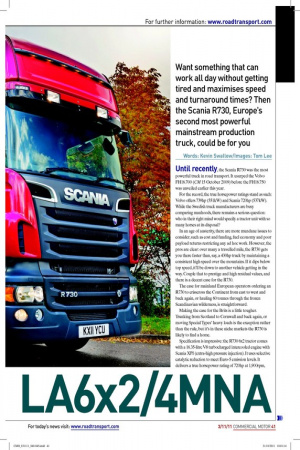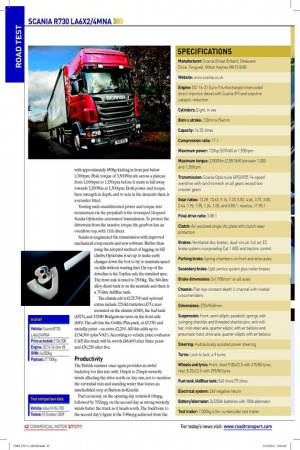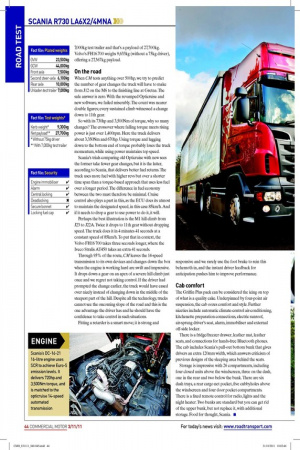Want something that can work all day without getting tired
Page 33

Page 34

Page 35

Page 36

If you've noticed an error in this article please click here to report it so we can fix it.
and maximises speed and turnaround times? Then the Scania R730, Europe's second most powerful mainstream production truck, could be for you
Words: Kevin Swallow/Images: Tom Lee
Until recently, the Scania R730 was the most powerful truck in road transport. It usurped the Volvo FH16.700 (CM 15 October 2009) before the FH16.750 was unveiled earlier this year.
For the record, the true horsepower ratings stand as such: Volvo offers 739hp (551kW) and Scania 720hp (537kW). While the Swedish truck manufacturers are busy comparing manhoods, there remains a serious question: who in their right mind would specify a tractor unit with so many horses at its disposal?
In an age of austerity, there are more mundane issues to consider, such as cost and funding, fuel economy and poor payload returns restricting any ad hoc work. However, the pros are clear: over many a travelled mile, the R730 gets you there faster than, say, a 430hp truck by maintaining a consistent high speed over the mountains. If it dips below top speed, it’ll be down to another vehicle getting in the way. Couple that to prestige and high residual values, and there is a decent case for the R730.
The case for mainland European operators ordering an R730 to crisscross the Continent from east to west and back again, or hauling 60 tonnes through the frozen Scandinavian wilderness, is straightforward.
Making the case for the Brits is a little tougher. Trunking from Scotland to Cornwall and back again, or moving Special Types’ heavy loads is the exception rather than the rule, but it’s in these niche markets the R730 is likely to ind a home.
Speciication is impressive: the R730 6x2 tractor comes with a 16.35-litre V8 turbocharged intercooled engine with Scania XPI (extra-high pressure injection). It uses selective catalytic reduction to meet Euro-5 emission levels. It delivers a true horsepower rating of 720hp at 1,900rpm, with approximately 650hp kicking in from just below 1,300rpm. Peak torque of 3,500Nm sits across a plateau from 1,000rpm to 1,350rpm before it starts to fall away towards 3,200Nm at 1,500rpm. Both power and torque have strength in depth, and to rein in the descents there is a retarder itted.
Turning such unadulterated power and torque into momentum via the propshaft is the revamped 14-speed Scania Opticruise automated transmission. To protect the drivetrain from the massive torque the gearbox has an overdrive top, with 11th direct.
Scania re-engineered the transmission with improved mechanical components and new software. Rather than using the adopted method of lugging on hill climbs, Opticruise is set up to make early changes down the box to try to maintain speed on hills without wasting fuel. On top of the driveline is the Topline cab, the standard spec. The front axle is rated to 7,500kg. The 540-litre alloy diesel tank is on the nearside and there is a 75-litre AdBlue tank.
The chassis cab is £125,700 and optional extras include 225Ah batteries (£75), rearmounted on the chassis (£340), the fuel tank (£525), and 315/80 Bridgestone tyres on the front axle (£60). The cab has the Grifin Plus pack, at £5,750, and metallic paint – an extra £2,200. All this adds up to £134,500 (plus VAT). According to vehicle price evaluator CAP, this truck will be worth £46,400 after three years and £30,250 after ive.
Productivity
The British summer once again provides an awful backdrop for this test, with 15mph to 25mph westerly winds affecting the drive north on day one, not to mention the torrential rain and standing water that forces an unscheduled stop at Burton-in-Kendal.
Fuel economy on the opening day returns 8.19mpg, followed by 7.02mpg on the second day as strong westerly winds batter the truck as it heads south. The backbone to the second day’s igure is the 5.96mpg achieved from the opening severe gradients section. Easy A-roads and motorways return 7.84mpg, while the tough motorway section scores 7.32mpg. The R730 uses 5% AdBlue, which equates to about £2.07/100km. Add that to the £41.36/100km fuel cost, the total cost per 100km is £43.43.
When we tested the Volvo FH16.700 (CM 15 October 2009), then the most powerful truck on the market, it returned 7.81mpg. Both sets of igures through the various sections mirror each other except for the easy A-roads/ motorway section where Volvo achieves 9mpg, more than 1.1mpg better than the R730 and gives Volvo FH16 the overall edge in fuel economy.
Compared with more mass-market 6x2 tractors, the Mercedes-Benz Actros 2546LS achieves 8.14mpg (CM 8 July 2010) and the Iveco Stralis AT450, which returns 8.11mpg (CM 27 August 2009).
Fully-fuelled, and without the mythical 75kg driver, Scania’s R730 weighs in at 9,300kg. Add the notional 7,000kg test trailer and that’s a payload of 27,700kg. Volvo’s FH16.700 weighs 9,633kg (without a 75kg driver), offering a 27,367kg payload.
On the road
When CM tests anything over 500hp, we try to predict the number of gear changes the truck will have to make from J12 on the M6 to the inishing line at Gretna. The safe answer is zero. With the revamped Opticruise and new software, we failed miserably. The count was nearer double igures; every sustained climb witnessed a change down to 11th gear.
So with its 730hp and 3,500Nm of torque, why so many changes? The crossover where falling torque meets rising power is just over 1,400rpm. Here the truck delivers about 3,350Nm and 670hp. Using torque and lugging down to the bottom end of torque probably loses the truck momentum, while using power maintains top speed.
Scania’s trials comparing old Opticruise with new sees the former take fewer gear changes, but it is the latter, according to Scania, that delivers better fuel returns. The truck uses more fuel with higher revs but over a shorter time span than a torque-based approach that uses less fuel over a longer period. The difference in fuel economy between the two must therefore be minimal. Cruise control also plays a part in this, as the ECU does its utmost to maintain the designated speed, in this case 85km/h. And if it needs to drop a gear to use power to do it, it will.
Perhaps the best illustration is the M1 hill climb from J23 to J22A. Twice it drops to 11th gear without dropping speed. The truck does it in 4 minutes 41 seconds at a constant speed of 85km/h. To put that in context, the Volvo FH16 700 takes three seconds longer, where the Iveco Stralis AT450 takes an extra 41 seconds.
Through 95% of the route, CM leaves the 14-speed transmission to its own devices and changes down the box when the engine is working hard are swift and impressive. It drops down a gear on an apex of a severe hill climb just once and we regret not taking control. If the driver had prompted the change earlier, the truck would have eased over nicely instead of changing down in the middle of the steepest part of the hill. Despite all the technology, trucks cannot see the oncoming slope of the road and this is the one advantage the driver has and he should have the conidence to take control in such situations.
Fitting a retarder is a smart move; it is strong and responsive and we rarely use the foot brake to rein this behemoth in, and the instant driver feedback for anticipation pushes him to improve performance.
Cab comfort
The Grifin Plus pack can be considered the icing on top of what is a quality cake. Underpinned by four-point air suspension, the cab oozes comfort and style. Further niceties include automatic climate-control air-conditioning, kitchenette preparation connections, electric sunroof, air-sprung driver’s seat, alarm, immobiliser and external off-side locker.
There is a fridge/freezer drawer, leather mat, leather seats, and connections for hands-free Bluetooth phones. The cab includes Scania’s pull-out bottom bunk that gives drivers an extra 120mm width, which answers criticism of previous designs of the sleeping area behind the seats.
Storage is impressive with 26 compartments, including four closed units above the windscreen, three on the dash, one in the rear and two below the bunk. There are six dash trays, a rear cargo net pocket, ive cubbyholes above the windscreen and four door pocket compartments. There is a ixed remote control for radio, lights and the night heater. Two bunks are standard but you can get rid of the upper bunk, but not replace it, with additional storage. Food for thought, Scania. ■













































